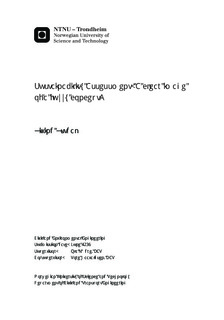| dc.description.abstract | The idea of sustainable development arose as a response to many unsustainable trends, which were closely linked to governance and policy-making. In many ways the term sustainability has been misused. In the early stages of policy assessment the main focus was reduction of regulatory costs, but when the principle of sustainability got better embedded, sustainability assessments of policies got more attention.
Sustainability assessments is an ex ante tool that uses different methods to emphasize synergy, adverse, short- and long-term effects of different alternatives of the policy proposal. Indicators are used when measuring sustainability in the three dimensions; economic, social and environmental. There are different ways of handling trade-offs, and it is important to set trade-off rules before the process begins. Many important questions need to be addressed when performing a sustainability assessment. Sustainability assessments need to be context-specific because sustainability issues are related to the people and the area that are affected by the proposal, this is also the reason why stakeholder participation is important. These kinds of assessments can be vulnerable for manipulation, and to deal with this one must have an open process where stakeholders participate. The sustainability assessment process is a learning process that should have adequate resources for constantly seeking improvements.
It makes sense to separate objectives on different perspective levels to cope with the different stakeholder objectives. Operational level corresponds to project outputs, tactical level corresponds to the project goals (first order effects) and strategic level corresponds to the project purpose (second order effects). The purpose with arranging indicators to these levels is to predict sustainability impacts on each specific level. The choices one make on operational level have influence for the other levels.
Many States have introduced some sort of policy assessment, and the practice and quality of these systems varies considerably. How decision-makers interpret and cope with scientific advice's also varies.
Conclusion
Sustainability assessment with indicators on operational, tactical and strategic levels is adequate for assessing sustainability of policies, plans, programmes and projects because the levels affect each other. A policy must be optimized to achieve sustainability on all levels. The results of this thesis, which were obtained by analyzing case-specific sustainability assessments, show that there are some shortcomings when it comes to using indicators on an operational level.
Switzerland managed to implement a sustainability assessment system for federal policies, while Belgium did not succeed. Norway governance is not adequate when it comes to assessing sustainability for large public projects. | |

